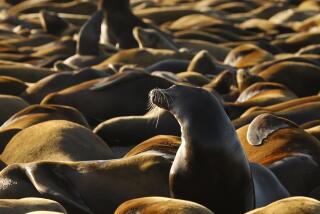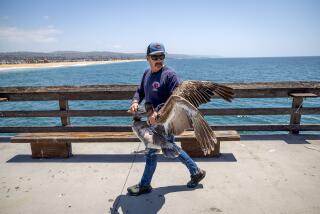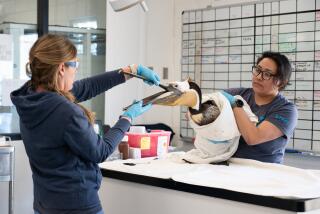REGIONAL REPORT : Brown Pelican Mutilations Resume--on Wider Scale
LAGUNA NIGUEL — Linda Evans has nursed back to health many brown pelicans that have been intentionally burned, strangled and mutilated. But she has never been as shaken by an act of cruelty as she was one March morning when she received a report that a young pelican had been crucified on a light pole.
“I was horrified. It’s a feeling that comes from an act so ugly and awful you can’t even describe what goes on inside you,” said Evans, who runs the Pacific Wildlife Center, a Laguna Niguel sea bird rescue center. “I don’t understand how someone can do that to a living thing.”
Ten years after nearly two dozen pelicans were found with their beaks hacked off in Dana Point Harbor, the mutilations have resumed--this time along the entire Southern California coastline.
From Santa Barbara to San Diego, authorities say that over the last six months they have received roughly 30 reports of atrocities involving the federally protected species, including:
* The Newport Beach crucifixion, where a boatman spotted the pelican hanging from a light pole, its soft gullet and wings impaled on large metal pins, say authorities. The bird eventually died.
* About half a dozen birds have been discovered with their beaks sawed off in Ventura, Redondo Beach, Marina del Rey and Dana Point this summer. Animal rescue volunteers say they have seen other similarly mutilated birds floating beyond reach in the ocean.
* In a rarely prosecuted atrocity, two pelicans were attacked and one killed by a fisherman in Dana Point Harbor. The incident was witnessed by two young Dana Point brothers, who reported the slaying to authorities. The fisherman was arrested and ultimately convicted on a charge of cruelty to animals.
* Two other criminal cases involving pelicans are being prepared by the U.S. Fish and Wildlife Service. In one incident, a deckhand on a commercial fishing boat grabbed a pelican by the beak and swung it like a baseball bat against a wall, then threw the seriously injured bird into the ocean.
The violence against pelicans ebbs and flows with El Nino, a climatic condition that occurs when a large area of water warms off the coast of Latin America.
Experts say that when the El Nino waters reached the California coast this spring, the herring and anchovies that form the mainstay of the brown pelican’s diet were driven away. Starving pelicans began flocking toward piers and marinas along the coast in search of food, and bringing them into conflict with fishermen.
Unable to distinguish between fresh-cut bait and the fish they normally eat, the birds swoop onto the baited hooks of anglers--almost invariably snaring themselves on the barbed hooks.
“The people who bill-chop or crucify these birds aren’t just acting out of frustration from losing (bait) fish,” said Paul Chang, special agent for U.S. Fish and Wildlife, which--for the first time since the 1982 beak slashings--is offering rewards in hopes of stemming the mutilations. “This is real demented stuff. Somebody twisted enough to commit an act like that isn’t going away.”
By early August, the number of injured pelicans at the Pacific Wildlife Center in Laguna Niguel soared to 15 per day, from the center’s normal treatment rate of three birds a week. About the same time, the Santa Barbara Wildlife Care Network reported a similar surge. Although the numbers have since leveled off, many pelicans are still recuperating at the two shelters and the memories remain vivid for shelter volunteers.
“Words can’t describe what was going on,” Evans said. “We were constantly sewing up pelicans, changing bandages on pelicans, feeding pelicans. It was like working in a MASH unit.”
Many injuries, Evans said, are attributed to thoughtless and possibly malicious fishermen. Rather than slowly reeling in a snared pelican and carefully removing the hook, fishermen sometimes just cut their lines. The remaining lines often become snagged on rocks or pilings, or ensnarled around the birds’ wings. Immobilized, the terrified birds usually starve to death.
Or worse, a fisherman will just yank hard on the pole, tearing the soft flesh of the gullet, and frequently leaving large gashes. Again, the bird usually starves to death because the fish it catches and normally traps in its gullet slips through.
It is a violation of federal law to injure or kill a protected species. The penalties can be heavy: fines up to $5,000, and jail terms up to six months. Civil penalties can reach $25,000.
But violators are seldom caught. “You have to be real lucky to catch someone in the act,” Chang said.
Chang depends on witnesses to report the atrocities. Two whistle-blowers, brothers Daniel and Matthew Lamb, ages 12 and 10, respectively, are responsible for the only successful prosecution in Southern California this year of someone who killed a brown pelican.
While fishing on a raft in Dana Point Harbor on the morning of July 7, the brothers watched as two other fisherman in a nearby canoe--Jeffrey McKinney, 20, and Mark McClelland, 26, both of Dana Point--struck out at two brown pelicans.
The men took several swings with an oar at the pelicans, which had snatched their bait and gotten hooked, said Daniel Lamb. The first bird escaped with a broken wing but the second was killed by a single blow from McKinney.
“I was scared to say anything at first, but then I yelled at them to just cut the line,” Daniel said. One of the men “just said, ‘That hook’s worth more than the pelican,’ ” he recounted.
McKinney and McClelland were arrested, although charges against McClelland were dismissed. McKinney pleaded guilty to misdemeanor animal abuse and was sentenced to one year’s probation and 10 days of public service.
McKinney recently moved from the area, according to his fishing buddy and former roommate, McClelland. “I want to make it clear,” McClelland said. “I’m not a bird- or an animal-hater. I have respect for the ocean.”
Chang said the Lamb boys will split about $1,000 in reward money. “Those kids showed a lot of guts turning in men who are twice their size,” he said. “I wish more people showed their courage.”
The brown pelican has evolved little in the 40 million years it has been known to inhabit the Earth, scientists say. But the last quarter century has been the roughest for them. The species, found to be on the brink of extinction, was extended endangered-species protection in 1970.
In the 1980s, humankind didn’t help matters. In addition to the Dana Point mutilations, a Redondo Beach bait vendor was convicted in 1983 of electrocuting seven pelicans with a device he had built to protect his bait containers. He was jailed for seven days and put on probation for an additional three years. In Huntington Beach the same year, a boat captain pleaded guilty and was fined $1,200 for using pliers to torture and kill a brown pelican.
Farther north in Monterey, 30 pelicans were found mutilated, most of them slashed in the neck and pouch with a knife. Authorities suspected that many of the slashings were the work of one person, but even a $20,000 reward didn’t succeed in revealing the identity of an attacker.
Often, the group expressing the most outrage over pelican atrocities is the fishing community itself.
Outside Turk’s bar in the Dana Point Harbor, a popular watering hole for sailors and fishermen, Norm Hackbarth took note of the mutilations and snorted in disgust during a recent interview.
“Anybody that would do those kinds of things to a pelican ain’t no fisherman. Those people are sick,” said Hackbarth, a regular at the harbor since 1948.
The good news is that despite being poisoned, starved, mutilated and fouled by oil slicks, the brown pelican is no longer in immediate danger of extinction, said Fred Gress, a research biologist with UC Davis. Over the last 20 years, the population of brown pelicans in Southern California has grown from about 2,000 to between 20,000 and 30,000.
“Pelicans can be pretty tough,” Gress said.
Plight of the Pelican
El Nino Effect
When the warm El Nino waters arrive off the coast f Southern California; the Pacific herring and anchovies that are a staple of the brown pelican’s birds must range farther from birds must range farther from nests for food. A look at what has occurred on Anacapa Island, the major breeding ground for pelicans in Southern California
Danger From Humans:
Don’t feed pelicans by hand. They are not considered dangerous, but hand-feeding causes them to flock together. That can promote disease and encourages the birds to stay by piers and wharves and not go out to the ocean to breed.
Don’t engage in chumming (throwing out live bait to attract game fish) close to pelican colonies. It encourages the same dangerous behavior.
Do squirt water from a hose to drive pelicans away from a boat, dock or pier area.
Do report any pelican abuse or injured birds to the Harbor Patrol or lifeguard station.
Source: UC Davis
Researched by FRANK MESSINA / Los Angeles Times










